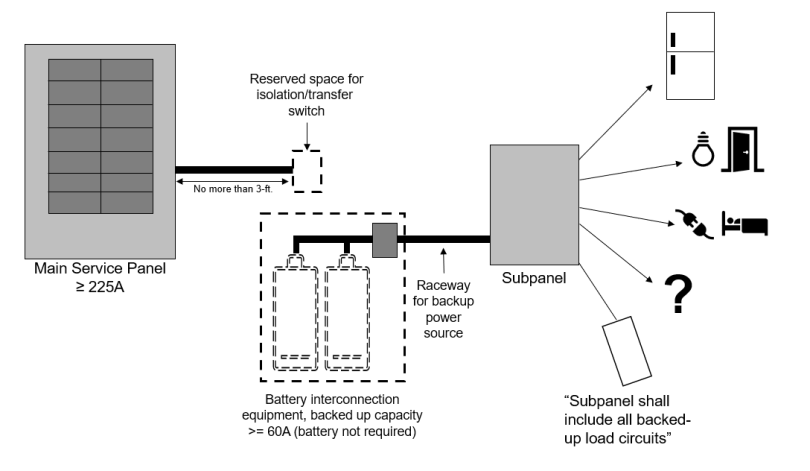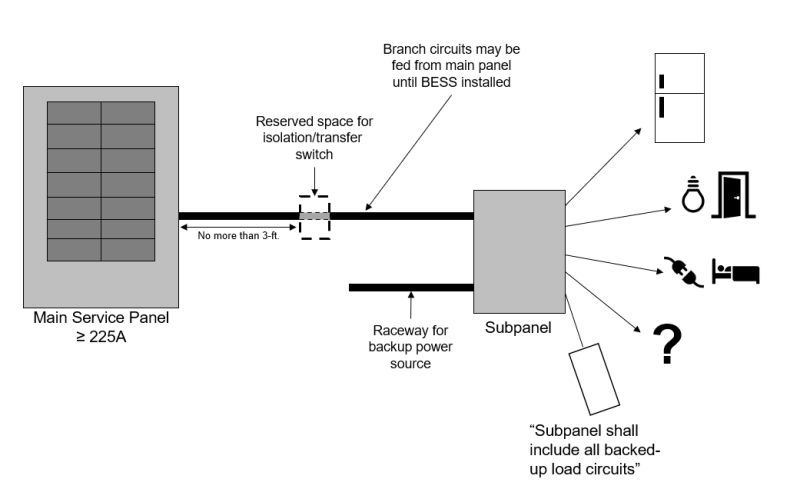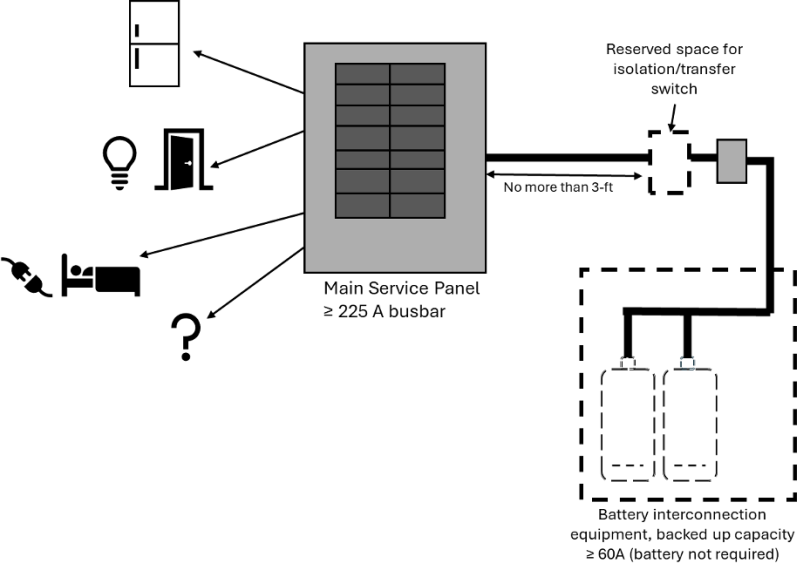Overview
Under the 2025 Energy Code, a battery energy storage system is defined as stationary equipment that receives electrical energy and then use batteries to store that energy for later use to supply electrical energy when needed. BESS consists of one or more modules, a power conditioning system, and balance of plant components.
General Information
Section 150.0(s) - PDF of the 2025 Energy code requires that all newly constructed single-family buildings with one or two dwelling units, where the load-serving entity provides the dwelling unit electrical service greater than 125 amps must be battery energy storage system (BESS) ready, with one exception (see below).
These requirements are mandatory but do not apply to:
- Additions
- Alterations
The requirements in Section 150.0(s) - PDF of the 2025 Energy Code include:
- Either:
- BESS-ready interconnection equipment with a minimum backed-up capacity of 60 amps and minimum of four BESS-supplied branch circuits per Section 150.0(s)2 - PDF (see Figure 2); or
- A dedicated raceway from the main service to subpanel supplying branch circuits per Section 150.0(s)2
- Can supply branch circuits via main service panel before BESS is installed
- Minimum raceway trade size of one inch
- Subpanels must be labeled “Subpanel shall include all backed-up load circuits”
- A minimum of four branch circuits and their source at a single panelboard supplied by the BESS. At least one circuit shall supply:
- Refrigerator,
- Lighting near primary egress, and
- Sleeping room receptacle outlet
- The main panelboard must have a minimum busbar rating of 225 amps
- A space reserved for a future installation of system isolation equipment/transfer switch within 3 feet from the main panel
Yes. There is one exception that excludes single family buildings from the BESS ready requirements.
- Buildings with BESS installed are not required to meet Section 150.0(s) - PDF.
Frequently Asked Questions
Yes. The 2025 Energy Code BESS ready requirements in Section150.0(s) – PDF apply to all single-family residences that include one or two dwelling units.
Yes. Duplexes are considered two single-family homes. Each duplex unit would have a separate panel with 225-amp busbar rating to meet the BESS-ready mandatory requirements in Section 150.0(s) – PDF.
No. Per the definition in Section 100.1-PDF, a townhouse is a single-family dwelling unit constructed in a group of three or more attached units. Townhouses do not need to meet the BESS-ready requirements in Section 150.0(s) – PDF.
Yes. A newly constructed accessory dwelling unit of any size must meet the battery energy storage system ready requirements per Section 150.0(s) - PDF. If the electric service for the ADU is 125 amps or less, the BESS-ready requirements will not apply as indicated in Section 150.0(s). The ADU must also meet the electric ready requirements in Section 150.0(t) – (v) - PDF when installing gas appliances. (See 2022 Single Family Electric-Ready Factsheet) NOTE: The electric-ready requirements for the 2025 Energy Code did not change and are the same as for the 2022 code cycle.
No. If the new residential building does not include a dwelling unit, such as pool house, art studio, office, etc., then it does not need to meet the BESS-ready requirements.
Yes. A 200-amp panel could meet the requirements if the busbar rating is 225 amps, and it is clearly marked on the panel. However, if there is no specific busbar rating on the panel, the 200-amp panel will not meet the requirements since the busbar rating will be the same as the panel rating. Panels must also meet the applicable requirements in the California Electrical Code.
No. The subpanel to the ADU from the main panel could meet Section 150.0(s)1B – PDF, if the main panel has the 225-amp busbar rating.
Yes. Per Section 150.0(s)1A - PDF BESS-ready interconnection equipment is required to have a 60-amp backed-up capacity and a minimum of four BESS-supplied branch circuits. See Figure 3. Various configurations of panels and subpanels could meet the BESS-ready requirements of Section150.0(s) - PDF.
Yes. Per Section 100.1 - PDF BESS-ready interconnection equipment is defined as equipment, including but not limited to a BESS-ready panelboard, that can accommodate the connection of a distributed energy resource or a BESS capable of either automatic or manual isolation from the utility power source. A BESS-ready panelboard is defined as a panelboard that can accommodate either automatic or manual switching between a utility power source to a distributed energy resource or battery energy storage system, such as a split bus panelboard.
See the Blueprint for more information, including articles and frequently asked BESS ready questions about the 2025 Energy Code.



